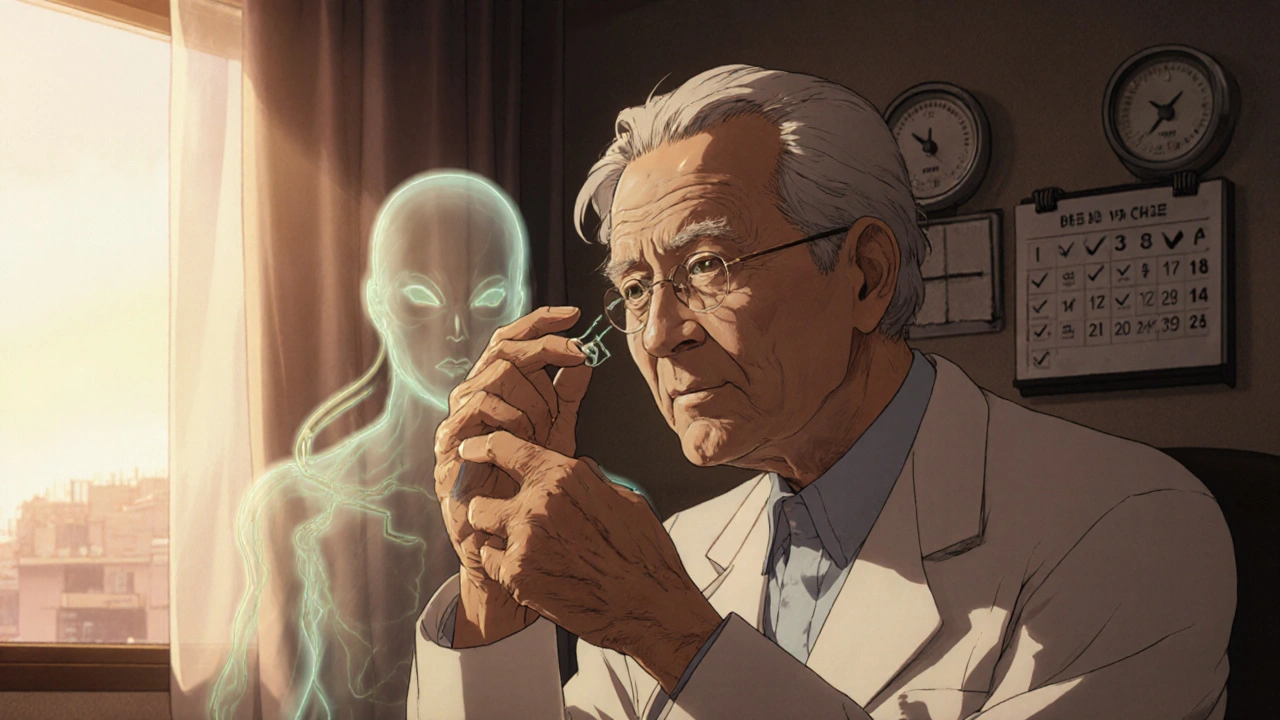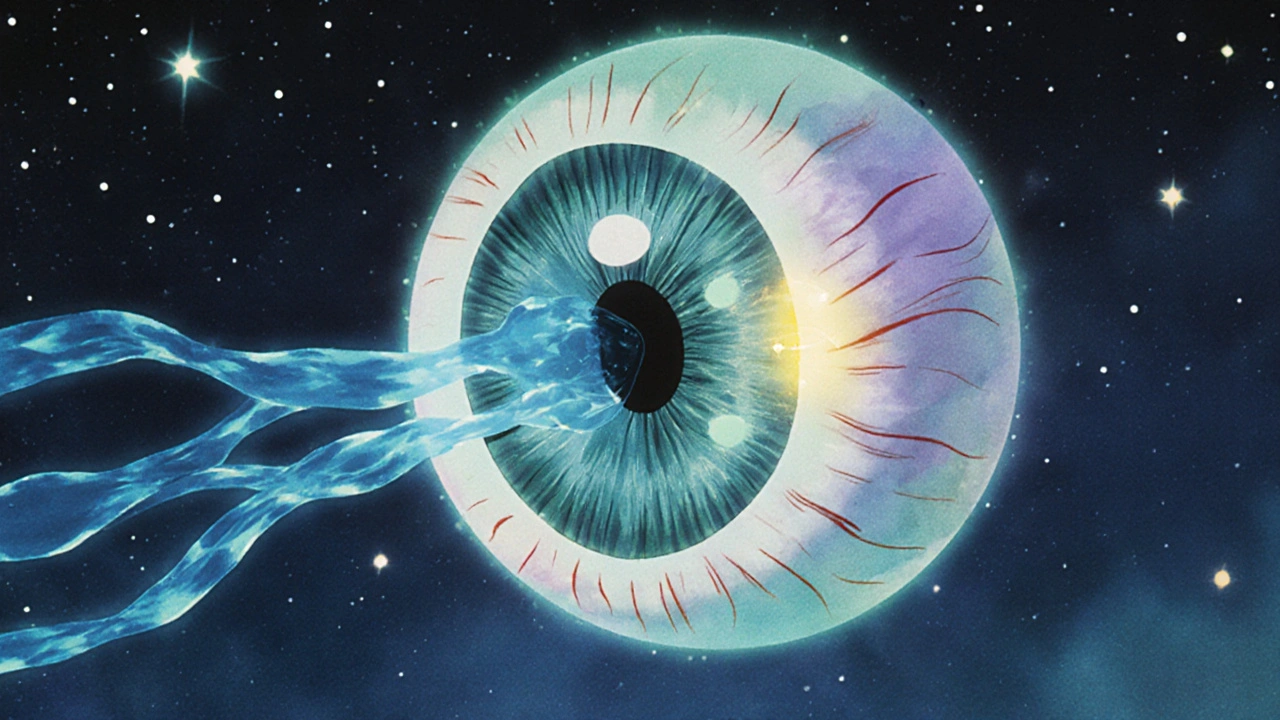Glaucoma doesn’t announce itself with pain or sudden vision loss. It creeps in quietly, slowly damaging the optic nerve until you realize you’ve lost peripheral vision-often too late. That’s why managing eye pressure isn’t just a recommendation; it’s the single most effective way to stop vision loss before it starts. And one of the most reliable tools doctors use to do that? Dorzolamide.
What Dorzolamide Actually Does in the Eye
Dorzolamide isn’t a miracle cure. It doesn’t restore lost vision. But it does something critical: it lowers intraocular pressure (IOP) by targeting the root cause of fluid buildup in the eye. It belongs to a class of drugs called carbonic anhydrase inhibitors. These drugs block an enzyme called carbonic anhydrase, which is found in the ciliary body-the part of the eye that produces aqueous humor, the fluid inside your eye.
When this enzyme is inhibited, less fluid is made. Less fluid means less pressure building up inside the eye. That’s it. No fancy mechanisms. No dramatic effects. Just a steady, reliable reduction in pressure. Studies show dorzolamide can lower IOP by 15% to 20% on average when used twice daily. That’s comparable to other first-line glaucoma medications like beta-blockers, but with fewer systemic side effects.
Why It’s Often Used Alongside Other Medications
Dorzolamide rarely works alone. That’s not because it’s weak-it’s because glaucoma demands multiple approaches. Most patients need more than one medication to reach their target pressure. Dorzolamide is especially useful in combination therapy because it works differently than other common eye drops.
Take beta-blockers like timolol. They reduce fluid production too, but through a different biological pathway. When you combine timolol with dorzolamide, you get additive pressure-lowering effects. Clinical trials have shown that this combination can reduce eye pressure by up to 30% more than either drug alone. That’s why fixed-dose combinations like Cosopt (timolol + dorzolamide) became so popular-they simplify dosing and improve adherence.
It also pairs well with prostaglandin analogs like latanoprost, which increase fluid outflow instead of reducing production. Using dorzolamide with latanoprost gives you a one-two punch: less fluid made, more fluid drained. This is why many patients on three or more medications have dorzolamide in their regimen.
Who Benefits Most from Dorzolamide?
Not everyone needs dorzolamide. But it’s especially valuable for certain groups. Older adults who can’t tolerate systemic side effects from oral carbonic anhydrase inhibitors (like acetazolamide) often do well with the topical version. Dorzolamide stays mostly in the eye, so it’s less likely to cause tingling fingers, fatigue, or kidney stones-common problems with the pill form.
People with mild to moderate glaucoma who aren’t yet ready for laser or surgery also benefit. It’s a good middle ground between starting with a single drop and moving to invasive procedures. It’s also preferred in patients with asthma or chronic lung disease because, unlike beta-blockers, it doesn’t affect breathing.
And for those who’ve tried prostaglandins but still have pressure above target? Dorzolamide is often the next step. It’s not flashy, but it’s predictable. And in glaucoma care, predictability saves sight.

Side Effects You Should Know About
No medication is without trade-offs. Dorzolamide’s most common side effect is a temporary stinging or burning sensation right after applying the drop. It lasts less than a minute for most people. Some report a bitter taste in the mouth-because a tiny amount drains into the nasal passages and throat. It’s unpleasant, but not dangerous.
Less common reactions include redness, dry eyes, or blurred vision right after use. These usually fade within days. Rarely, people develop an allergic reaction: swelling, itching, or a rash around the eye. If that happens, stop using it and contact your eye doctor immediately.
Unlike some glaucoma drops, dorzolamide doesn’t cause eyelash growth or iris color change. That’s a plus for patients concerned about cosmetic side effects. And because it’s not absorbed systemically in large amounts, it’s safer for long-term use than oral alternatives.
How It Fits Into the Bigger Picture of Glaucoma Care
Glaucoma isn’t managed with one drug, one appointment, or one solution. It’s a lifelong process of monitoring, adjusting, and sometimes upgrading treatment. Dorzolamide plays a steady role in that process. It’s not the first choice for everyone-prostaglandins often are, because they’re once-daily and highly effective. But dorzolamide fills a crucial gap.
When prostaglandins aren’t enough, or when patients can’t use them due to allergies or cost, dorzolamide steps in. When pressure drops too low with one medication and you need to avoid over-treatment, dorzolamide’s moderate effect helps fine-tune results. And when patients need to reduce the number of daily drops, the fixed-combination versions make it easier to stick to the plan.
It’s also one of the few options that can be used safely in patients with kidney issues, since it doesn’t rely on renal clearance like some oral drugs. That makes it a go-to for older adults with multiple health conditions.

What Happens If You Stop Using It?
Stopping dorzolamide doesn’t cause rebound pressure spikes like some other glaucoma medications. But that doesn’t mean it’s safe to quit. Without it, fluid production returns to normal, and pressure creeps back up. Over weeks or months, that means more damage to the optic nerve.
Many patients stop using their drops because they forget, or because they feel fine. But glaucoma doesn’t give you symptoms until it’s too late. If your pressure was 24 mmHg before starting dorzolamide and it dropped to 16 mmHg, that’s a 33% reduction. That’s the difference between slowly losing your side vision and keeping it for decades.
That’s why adherence matters more than the specific drug. Whether it’s dorzolamide, latanoprost, or brimonidine-the goal is consistent pressure control. Dorzolamide’s twice-daily dosing can be a hurdle, but using it with a reminder app or pairing it with morning and evening routines helps.
Alternatives and When to Consider Them
There are other options if dorzolamide doesn’t work or causes irritation. Brimonidine is another option that reduces fluid production and also improves drainage. But it can cause dry mouth, fatigue, or low blood pressure in some people. Rho kinase inhibitors like netarsudil are newer and very effective, but they’re expensive and can cause redness and corneal deposits.
For patients who can’t tolerate drops at all, laser treatments like SLT (selective laser trabeculoplasty) are now recommended as first-line in many cases. But for those still managing with medication, dorzolamide remains a trusted, well-studied tool.
What’s clear is that glaucoma care isn’t about finding the "best" drug. It’s about finding the right combination for your body, your lifestyle, and your pressure goals. Dorzolamide isn’t glamorous. But it’s dependable. And in a disease where every millimeter of pressure matters, dependability is everything.
Is dorzolamide a first-choice treatment for glaucoma?
Not always. Prostaglandin analogs like latanoprost are usually the first choice because they’re once-daily and very effective at lowering pressure. But dorzolamide is often added when prostaglandins alone aren’t enough, or when patients can’t use them due to allergies, cost, or side effects. It’s a key second-line or combination option.
Can dorzolamide cure glaucoma?
No. Glaucoma is a chronic condition with no known cure. Dorzolamide helps control intraocular pressure, which slows or stops further damage to the optic nerve. It protects vision but doesn’t restore vision that’s already been lost.
How long does it take for dorzolamide to work?
You’ll start to see pressure reduction within a few hours after the first dose. But it takes about 1 to 2 weeks of consistent twice-daily use to reach its full effect. Regular monitoring by your eye doctor is needed to confirm it’s working as expected.
Can I use dorzolamide with contact lenses?
Yes, but remove your contacts before applying dorzolamide. Wait at least 15 minutes after the drop before putting them back in. The preservative in the solution can be absorbed by soft lenses and cause irritation.
Does dorzolamide cause weight loss or fatigue?
Rarely. Oral carbonic anhydrase inhibitors like acetazolamide can cause fatigue, weight loss, and tingling, but dorzolamide is applied directly to the eye. Very little enters the bloodstream, so systemic side effects are uncommon. If you feel unusually tired or lose weight suddenly, talk to your doctor-it’s unlikely to be from dorzolamide, but worth checking.







Alex Hundert
30 October, 2025 16:57 PMDorzolamide might not be flashy, but it’s the quiet workhorse that keeps thousands from going blind. I’ve seen patients who couldn’t tolerate beta-blockers because of asthma-dorzolamide saved their vision without making them gasp for air. No drama, just results.
Emily Kidd
31 October, 2025 23:12 PMsooo i’ve been on dorzolamide for 3 years and honestly? the stinging sucks at first but u get used to it. the bitter taste is wild tho-like i just licked a battery lmao. but my pressure’s been stable since day one. no complaints.
caiden gilbert
1 November, 2025 15:34 PMIt’s weird how something so unglamorous-no eyelash growth, no color changes, no ‘miracle’ claims-ends up being the most reliable tool in the box. Dorzolamide doesn’t scream for attention, but it’s the one you want at 3 a.m. when your IOP is creeping up. Quiet strength.
MOLLY SURNO
2 November, 2025 05:32 AMI appreciate how clearly this was written. As someone who’s watched a parent navigate glaucoma, I can say that clarity like this matters more than we realize. Many patients are overwhelmed by jargon-this cuts through it with grace.
Justin Cheah
3 November, 2025 05:07 AMLet’s be real-dorzolamide is just Big Pharma’s way of keeping you hooked on eye drops while they push the expensive combo pills. Why not just fix the drainage system with laser instead of pumping your eye with chemicals every day? The system doesn’t want you cured-it wants you compliant. And don’t get me started on Cosopt’s pricing. It’s a cash cow disguised as medicine.
phenter mine
3 November, 2025 20:01 PMi didnt know dorzolamide could be used with contacts as long as u wait 15 min. i always just took mine out and forgot to put them back-my eyes felt so dry. this is a game changer thanks for sharing!!
Aditya Singh
4 November, 2025 21:46 PMWhile dorzolamide inhibits carbonic anhydrase isoform II in the ciliary processes, the downstream modulation of bicarbonate ion transport and aqueous humor dynamics is statistically insignificant in patients with advanced optic neuropathy. The 15–20% IOP reduction cited is merely a placebo-adjusted artifact in phase II trials with inadequate power. We must consider the confounding variable of diurnal IOP fluctuation.
Katherine Reinarz
6 November, 2025 06:08 AMOMG I JUST REALIZED I’VE BEEN USING DORZOLAMIDE WRONG ALL THIS TIME?? I’VE BEEN BLINKING IMMEDIATELY AFTER THE DROP AND NOW MY EYES ARE BURNING?? I THOUGHT IT WAS JUST ME 😭😭😭
John Kane
7 November, 2025 05:41 AMGlaucoma doesn’t care how rich you are, how young you are, or how healthy you think you are. It just waits. And tools like dorzolamide? They’re not just drugs-they’re time machines. They buy you years. Maybe decades. I’ve seen people who thought they’d lose sight by 50-now they’re hiking in their 70s because they didn’t skip a drop. That’s the quiet miracle.
Callum Breden
7 November, 2025 20:15 PMThe assertion that dorzolamide is 'reliable' is a gross oversimplification. The clinical data is inconsistent across ethnic subgroups, particularly in East Asian populations where systemic absorption may be elevated due to pharmacokinetic variance. Furthermore, the study cited fails to control for concomitant use of antihypertensives, thereby invalidating the claimed 15–20% efficacy. This is not medicine-it’s anecdotal marketing dressed in peer-reviewed clothing.
Erin Corcoran
9 November, 2025 05:32 AMJust wanted to say-dorzolamide + latanoprost combo saved my vision 😊 I used to forget my drops until I started pairing them with brushing my teeth-morning latanoprost, night dorzolamide. Life’s weird little routines, huh? 🙌
shivam mishra
9 November, 2025 18:39 PMAs an optometrist in rural India, I see patients who can’t afford prostaglandins. Dorzolamide is often the only affordable, effective option. It’s not perfect-some find the twice-daily dosing hard-but it’s accessible, stable, and doesn’t require refrigeration. In resource-limited settings, it’s not just a drug. It’s hope.
Mansi Gupta
10 November, 2025 09:23 AMThank you for writing this with such care. I’ve been on dorzolamide for five years and never fully understood why it was chosen for me until now. The explanation about combining mechanisms-reducing production while others increase outflow-made it click. I feel less like a patient and more like a participant in my own care.